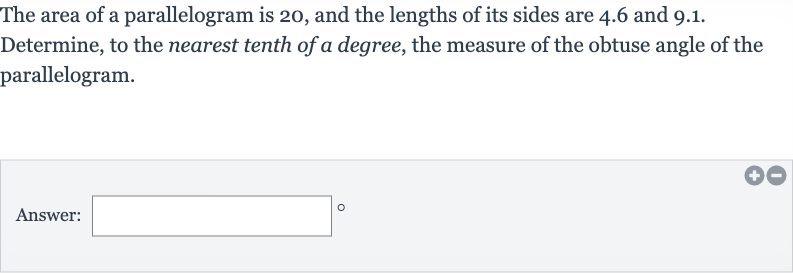Full solution
Q. The area of a parallelogram is , and the lengths of its sides are . and .. Determine, to the nearest tenth of a degree, the measure of the obtuse angle of the parallelogram.Answer:
- Formula Explanation: The area of a parallelogram is given by the formula , where the base is one side of the parallelogram and the height is the perpendicular distance from the base to the opposite side. We can use this formula to find the height of the parallelogram.
- Height Calculation: Let's choose the side with length as the base. Then, we can calculate the height () using the area () and the base ():
- Trigonometry Application: Now that we have the height, we can use trigonometry to find the measure of the obtuse angle. The height forms a right triangle with the base and the side of the parallelogram. The obtuse angle is supplementary to the acute angle of this right triangle.
- Acute Angle Calculation: Let's call the acute angle . We can use the cosine function, which relates the adjacent side (base), the opposite side (height), and the angle :
- Obtuse Angle Calculation: Now we can find the acute angle by taking the inverse cosine () of :
- Final Rounding: Since the obtuse angle is supplementary to the acute angle, we can find it by subtracting the acute angle from : Obtuse angle = Obtuse angle = Obtuse angle
- Final Rounding: Since the obtuse angle is supplementary to the acute angle, we can find it by subtracting the acute angle from : Obtuse angle = Obtuse angle = Obtuse angle We round the obtuse angle to the nearest tenth of a degree as requested: Obtuse angle
More problems from Find the magnitude of a three-dimensional vector
QuestionGet tutor help
QuestionGet tutor help
QuestionGet tutor help
QuestionGet tutor help
QuestionGet tutor help
QuestionGet tutor help

